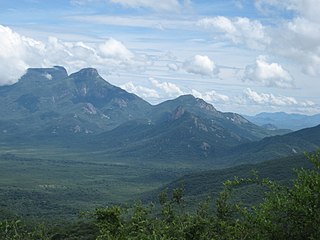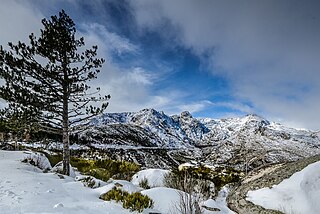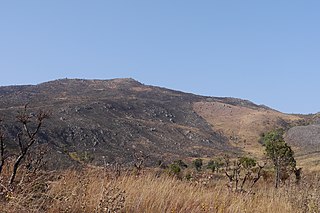
Huíla is a province of Angola. It has an area of 79,023 square kilometres (30,511 sq mi) and a population of 2,497,422. Lubango is the capital of the province. Basket-making is a significant industry in the province; many make baskets out of reeds.

Lubango, formerly known as Sá da Bandeira, is a municipality in Angola, capital of the Huíla Province, with a population of 914,456 in 2022. The city center had a population of 600,751 in 2014 making it the second-most populous city in Angola after the capital city Luanda.

The Serra da Chela is a mountain range in south-central Angola. The mountains, rising to 2,306 meters (7,566 ft) above the coastal plains, are among the highest in the country. It forms part of the Great Escarpment of southern Africa, separating the Huíla Plateau of the interior from the low-lying coastal Namib Desert.

The Agostinho Neto University is the largest public university of Angola, based in Luanda and in the nearby city of Talatona, in Angola. In the academic year 2005–06, 68 licensing courses were ministered by the university: 18 in Bachelor's and 15 in master's degrees, involving areas of scientific knowledge in the faculties, institutes, and higher learning schools. It is one of seven public universities in Angola. Until 2009 the Agostinho Neto University was the country's only public university, and had campuses in all its major cities. In 2009 it was split up, with its campuses outside Luanda becoming six autonomous universities, located in Benguela, Cabinda, Huambo, Lubango, Malange, and Uíge. Agostinho Neto University is now one of the seven regional university among others, serving Luanda Province and Bengo Province. It remains the largest university in Angola.

The 2010 Africa Cup of Nations, also known as the Orange Africa Cup of Nations for sponsorship reasons, was the 27th Africa Cup of Nations, the biennial football championship of Africa (CAF). It was held in Angola, where it began on 10 January 2010 and concluded on 31 January.

Serra da Estrela Natural Park is situated in the largest mountain range in Portugal - the Serra da Estrela, and is the source of the rivers Mondego, Zêzere, and Alva. The park is the largest natural conservation area in Portugal and occupies about 1,000 km². More than half of its area is located above an altitude of 700 m. At 1,993 m it contains the highest peak in Continental Portugal and a ski resort.

Clube Desportivo da Huíla is an Angolan football club based in Lubango, Huila. The club is attached to the Angolan Armed Forces and has close ties with Primeiro de Agosto. In the 2011–12 season of the Angolan second division, the club got promoted to the Girabola. They play their home games at the Estádio do Ferroviário da Huíla. On 17 April 2006 Agostinho Tramagal was appointed as their new coach.

Sport Lubango e Benfica, and best known as Benfica do Lubango, is an Angolan football club based in Lubango. They play their home games at the Estádio Nossa Senhora do Monte.

The Serra de Tramuntana is a mountain range running southwest–northeast which forms the northern backbone of the Spanish island of Mallorca. It is also the name given to the comarca of the same area. On 27 June 2011, the Tramuntana Range was awarded World Heritage Status by UNESCO as an area of great physical and cultural significance.

Angola is located on the western Atlantic Coast of Southern Africa between Namibia and the Republic of the Congo. It also is bordered by the Democratic Republic of the Congo and Zambia to the east. The country consists of a sparsely watered and somewhat sterile coastal plain extending inland for a distance varying from 50 to 160 km. Slightly inland and parallel to the coast is a belt of hills and mountains and behind those a large plateau. The total land size is 1,246,700 km2 (481,400 sq mi). It has an Exclusive Economic Zone of 518,433 km2 (200,168 sq mi).

Pedra da Mina is the fourth highest mountain in Brazil, located in the Serra Fina section of the Mantiqueira Mountains, one of the country's most important mountain ranges. The mountain stands on the border of the states of Minas Gerais and São Paulo, respectively to its north and south. With a 2,798-metre (9,180-ft) elevation, it is the highest point of the Mantiqueira Mountains and of the state of São Paulo, and the second highest mountain in the state of Minas Gerais.

Chipindo is a town and municipality, with a population of 64,714, in the province of Huíla, Angola.

The Angolan montane forest-grassland mosaic ecoregion is located on the east-facing inland side of the belt of mountains that stands parallel to the coast of Angola, 50–100 km inland.
Tundavala Gap is a viewpoint in the rim of the great escarpment called Serra da Leba. It is located some 18 km from the city of Lubango, in Huíla province, Angola.

Angolan cuisine has many dishes popular among nationals and foreigners. One of the most popular being funge, mufete. There is also calulu, moamba de galinha, moamba de ginguba, kissaca and so many more delicious dishes. In addition, there is also the extremely popular mukua sorbet.
The Angolan Second Division Basketball ChampionshipCampeonato Nacional de Basquetebol da Segunda Divisão, is the second tier men's basketball league in Angola. The competition, organized by the Angolan Basketball Federation and meant to be played on an annual basis, began in 2013.
Ornithogalum lebaense is a flowering plant that grows in southwest Angola. It was discovered in January 2009 by Ernst Jacobus van Jaarsveld. The word "lebaense" refers to Leba Pass, where the plant lives. O. lebaense does not have a known common name, most likely because its habitat is not one that is easily accessible by local people. There are three other Ornithogalum species identified in Angola: Ornithogalum tenuifolium, O. pulchrum and O. benguellens.
The 2010 Taça de Angola was the 29th edition of the Taça de Angola, the second most important and the top knock-out football club competition in Angola, following the Girabola. Atlético Sport Aviação beat G.D. Interclube 4–3 in a penalty shoot-out after a scoreless draw in regular time, to secure its 3rd title.
Mandume ya Ndemufayo University is a public university in Lubango, Angola, established in 1963 named after the late Kwanyama King Mandume ya Ndemufayo. The university emerged from the dismemberment of the Lubango campus of the Agostinho Neto University in the midst of the reforms in Angolan higher education that occurred in the years 2008 and 2009.
















